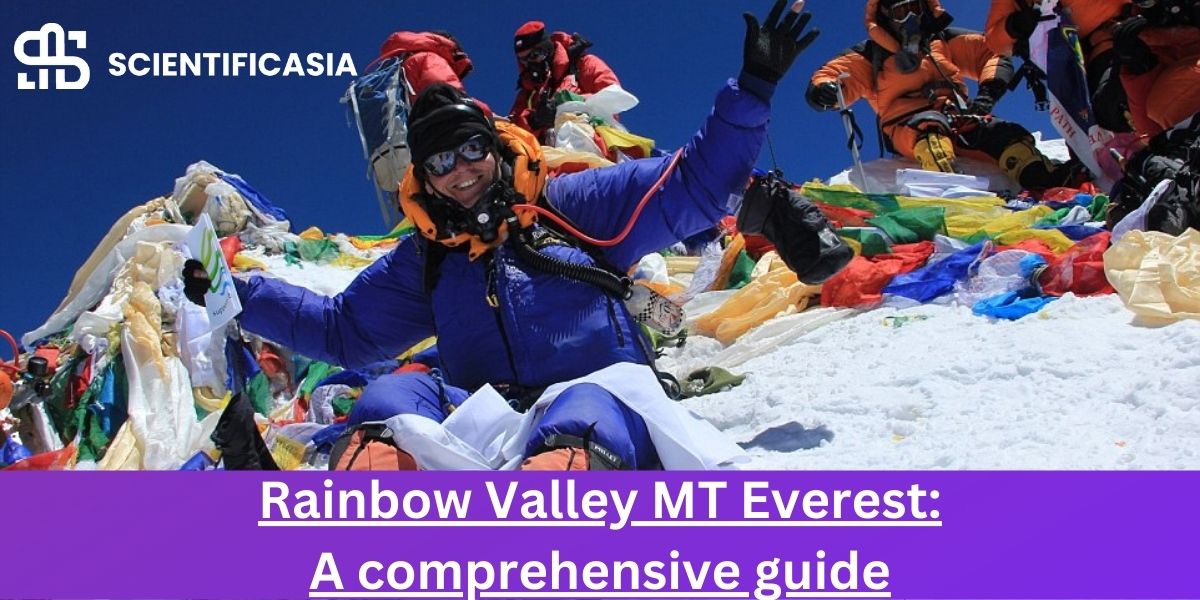Everest has enthralled people all across the world ever since it was acknowledged as the highest peak on Earth. It is well-known for its breathtaking beauty and enormous height. But a lesser-known feature, sometimes referred to as the “Rainbow Valley MT Everest,” reveals Everest’s darker side. This essay seeks to clarify this enigmatic place and offer crucial details for people thinking about climbing there.
Even though the name “Rainbow Valley MT Everest” could conjure up ideas of a gorgeous setting, the actual situation is very different. This area serves as an eerie climbers’ cemetery. It is located at an elevation of more than 8,000 meters beneath Mount Everest’s northern ridge. Many corpses are strewn all over the place, serving as a clear reminder of the dangers associated with the mountain.
These bodies, with their vivid orange, red, blue, and green jackets, give the place its colorful name. Multicolored trash, such as tents, cans, and oxygen tanks, placed next to the bodies further enhances the impression of a rainbow.
Climbers attempt to reach their peak every year. A few are successful, some fail, and sadly, some people lose their lives. The majority of these deaths take place above 8,000 meters, in what is known as Everest’s “death zone.” Thin air, severe weather, and strong winds characterize this hazardous environment, making survival a never-ending struggle. There’s not much room for the fallen in the death zone’s tight paths. Frequently brushed aside, the dead end up at Rainbow Valley as their final resting place.
Retrieving the dead from such hazardous terrain is a dangerous task that takes a large team and a lot of work. Because of this, the bodies stay undisturbed, and every year, Rainbow Valley MT Everest gets busier and busier. To fully comprehend Rainbow Valley on Mount Everest, one must first familiarize themselves with the idea of the “death zone.”
Knowledge of Altitude Sickness
Climbers run the danger of developing acute mountain sickness, also known as altitude sickness, when ascending higher in altitude. This disorder develops as a result of the brain’s inadequate oxygen supply at high altitudes.
The air becomes thinner as climbers rise because the air’s atmospheric pressure drops and oxygen molecules scatter. This decreased oxygen availability hurts the body’s organs. It causes symptoms like coughing up fluid, trouble breathing, difficulty walking, dizziness, and even unconsciousness.
Blood viscosity rises, dehydration sets in, and the risk of a stroke increases under these circumstances. Altitude sickness can also seriously affect judgment. Every strenuous step made at high altitudes thus becomes a race against the clock and the limitations of the body.
What is the “Death Zone,” according to climbers?
Any alpine region above 8,000 meters (26,247 ft) is known as the “death zone” on Mount Everest. This dangerous area has claimed more than 200 lives, so it has been dubbed the “death zone.”
With barely one-third of the usual quantity at sea level, the oxygen level is dangerously low at such high elevations. Climbers carry extra oxygen tanks on their ascent to reduce this risk. At these altitudes, an inadequate oxygen supply can cause altitude sickness and, in rare circumstances, even death.
The death zone’s trails are infamously tight and crowded, providing little space for the constant influx of climbers. Viral photographs show the lines of climbers waiting to finish their ascent during peak season. Climbers may be forced to spend a lot of time in the death zone due to this congestion. Consequently, it raises the inherent dangers of high-altitude mountaineering even more.
Rainbow Valley serves as a warning of the risk.
What to anticipate from Rainbow Valley
The heartbreaking moniker Rainbow Valley on Mount Everest comes from the brightly colored jackets that climbers who lost their lives on the summit wore. These bright-down garments, half-hidden by the snow, symbolize the rainbow’s colors: red, green, and blue.
Numerous of these deaths took place in the infamous Death Zone. Others were frequently forced to transfer their bodies off the path to make room for the dead climbers who died along the mountain trek.
Climbers on Everest are forced to put their personal survival first due to the harsh realities of the mountain. It’s literally a question of life or death on this dangerously small, slippery, and deadly trail.
Those who are still climbing need to concentrate on staying alive when they come across dead climbers. Climbers have to fight the impulse to sleep in the Death Zone, where altitude sickness can become incapacitating, because falling victim to the cold could be fatal.
The Creation of Mount Everest’s Rainbow Valley and the Deadly Reality of the Death Zone
The region above 8,000 meters (26,247 feet), often known as the Death Zone on Mount Everest, is well known for having a high death rate. Climbers may die from a potentially fatal oxygen shortage because of the very low oxygen levels in this area.
There is only room for one person at a time on the extremely tight trail leading to the summit inside the Death Zone. Consequently, the dead of those who die here are forced into Rainbow Valley MT Everest, where their bodies are interred for eternity.
The bodies of fallen climbers are either pushed off the trail into Rainbow Valley MT Everest or other places beneath the ridge, or they are stepped over. Recently certified Everest climber Chad Gaston talked about the difficulties he experienced getting past those who were too sick to move, like a mummy.
Since 1922, more than 300 climbers have perished in the Death Zone. At least nineteen climbers lost their lives to an avalanche in 2015. The remains of the fallen give Rainbow Valley MT Everest an ever-more vibrant appearance as the death toll rises.
Why is the Rainbow Valley of Mount Everest accumulating dead climbers?
What happens to the corpses in Mt. Everest’s Death Zone or Rainbow Valley? They usually stay like this forever because healing is incredibly difficult, if not impossible.
The strong winds make helicopter rescues impractical at such high altitudes, and the severe weather, winding routes, and high altitude provide considerable obstacles for body recoverers. Retrieving a single body frequently requires multiple people, a task that not everyone is willing to perform.
Recovering a body can cost more than USD 70,000. Even if some bodies have been found after paying this large amount, the procedure is still risky and may cause more deaths.
For example, two mountaineers from Nepal lost their lives in 1984 trying to retrieve a body from the Death Zone. A body’s successful retrieval is not guaranteed, not even with large financial resources. As a result, the bodies of climbers who have died on Mount Everest are piling up in Rainbow Valley MT Everest.
What is the primary reason for death on Everest?
The Death Zone, an area over 8,000 meters, is where most deaths on Mount Everest take place. There are many difficulties at this altitude, such as low oxygen levels, severe weather, high winds, and constrained paths. Every step is a matter of life and death because even a small mistake might have catastrophic consequences.
As of 2022, 6,098 distinct individuals had ascended to the top of Everest, for a total of (about) 11,346 peaks, with c.310 reported fatalities since 1924. In 1980, the death rate fell to less than 1%.
According to a BBC article, avalanches were responsible for about 30% of deaths on the mountain, while acute mountain sickness was responsible for 20% of deaths.
Other important elements that contribute significantly to mortality during Everest climbs are falls and tiredness.
The greatest death rate, 2.2%, was recorded in the 1970s and 1980s, although it has since dropped.
A Few Details About Mount Everest’s Rainbow Valley
- Everest has killed over 300 climbers since Tenzing Norgay and Edmund Hillary accomplished the first ascent that was officially recorded in 1953. The Death Zone was where the great bulk of these deaths took place.
- At these great altitudes, the air pressure drops, making it difficult for an ordinary person to breathe in more than 30% of what they would at sea level.
- In the Everest Death Zone, a person used to sea-level conditions would go unconscious in two to three minutes without sufficient acclimatization.
- Climbers estimate that it can take up to 12 hours to travel the 1.72 km between South Col and Everest’s summit due to the harsh conditions in the Death Zone.
- According to the study “Mortality on Mount Everest,” extreme exhaustion and delayed summit timing are early risk factors for later fatalities.
- One in four climbers on Mount Everest may experience retinal hemorrhages. These are usually less deadly in the Death Zone, even though they usually get better as you drop to lower elevations.
- According to an article in ABC Catalyst, one in twenty climbers who complete an ascent of Everest passes away on the way back to base camp.
- The Everest Death Zone is home to the majority of the frozen corpses on the peak.
- Over the years, climbers have successfully crossed the danger zone and returned from Everest despite these formidable hurdles.
Tales from Everest Base Camp
Climbers aiming to reach the top of Mount Everest begin their journey from Everest Base Camp. The region is dotted with mountaineering tent camps, and at the height of the season, the base camp is a riot of color with multicolored tents.
This serves as the last opportunity for climbers to refuel before starting their journey. Mountaineers frequently exchange songs, tales, and experiences with one another in base camp. There are a lot of stories circulated among climbers at Everest Base Camp about the bodies discovered in Rainbow Valley Mount Everest.
These tales include some of the most well-known ones, including Hannelore Schmatz, Sleeping Beauty, and Green Boots.
Everest in Green Boots
Everest expeditions are well-known for their “Green Boots” narrative, which has garnered a lot of media attention. The “surname” refers to a deceased climber who was on the peak’s northeast ridge.
Because of the oxygen tanks on its back and the green boots it wears, the body is known as Green Boots. The body is thought to be that of an Indian climber named Tsewang Paljor, who vanished on an ascent in 1996.
The same catastrophe claimed the lives of two more climbers, although their remains were never located. But Green Boots is still down in a little cave beneath the peak.
A hallmark of Everest climbers is this body. About eighty percent of them take a break in this cave on their ascent. In Rainbow Valley MT Everest, Green Boots is the most noticeable and well-known corpse.
Everest’s Sleeping Beauty
The tale of Francys Arsentiev, the first American woman to climb Mount Everest without the need for additional oxygen, is also well-known.
The event took place on May 22, 1998. The journey began for Francys and her spouse much like any other mountain ascent. Her ascent went well, but on the way down, she lost her bearings and ended up stuck on the mountain for three days without any more oxygen. Eventually, a rescue crew was sent to bring her down.
Francys was critically frostbitten, scarcely breathing, and on the verge of death when the team found her. They succeeded in lowering her as far as they could, but it was harder and harder to get any lower.
They were forced to abandon her to perish on the Everest slopes in the end. Francys was given the nickname “Sleeping Beauty” after being discovered laying on her back, appearing to be asleep.
The first woman to perish on Everest was Hannelore Schmatz.
The tragic honor of being the first woman to die on the slopes of Mount Everest belongs to German mountaineer Hannelore Schmatz. She embarked on a mission to ascend the highest peak on the globe with her spouse in 1979. The party made it to the summit without incident, but on the way down, Hannelore and American climber Ray Genet lost ground.
They decided to stay the night in Everest’s infamous death zone with a Sherpa because they were too tired to go on. Before dawn, Ray Genet perished to cold after a severe snowstorm. Both Hannelore and the Sherpa made it through the night, but at 8,290 meters, Hannelore passed out and disappeared, propped up by her rucksack, never to be seen again. She begged for water in her last words.
Hannelore’s body lay in the same position for years, her flowing hair and open eyes a menacing reminder of the dangers that the mountain may offer. On their ascents and descents, many climbers passed by her body. Five years later, two climbers tragically perished trying to retrieve her body; their remains were discovered on the mountain, tangled in ropes. Strong winds carried Hannelore’s body off the ridge a year later. Her experience serves as a terrifying reminder of Mount Everest’s perils.
Mallory, George
An important turning point in Everest’s history occurred when George Mallory’s body was found in 1999, 75 years after he died in 1924. To become the first person to summit Mount Everest, George Mallory and his climbing partner Andrew Irvine vanished during the journey. It is unknown if they made it to the summit before meeting their demise.
Renowned mountaineer Conrad Anker discovered Mallory’s body in 1999 while making a documentary with his team during an exceptionally warm spring. Mallory’s name was sewn onto a tag that served as a means of identification. His left arm, a portion of his legs, and his upper torso were all remarkably well preserved despite the intense cold.
Mallory’s body has a shattered leg bone, indicating that he had probably fallen or slipped and become disabled. High gusts and severe weather eventually wore off sections of his body, exposing skin and clothing. But the body was still mostly frozen, thanks to the intense cold.
Mount Everest Ascent
Yes, even if climbing Mount Everest comes with a lot of risks and hardships, it’s still the ultimate goal for a lot of climbers worldwide. For many people, it is worth taking risks to reach the highest point on Earth because of the unmatched sense of success that comes with it.
With a death rate of less than 1% and hundreds of climbers having reached the top, Mount Everest continues to draw travelers from all over the world. The southern route, which begins in Nepal, and the northern route, which begins in Tibet, are the two main ways to the summit. The most popular and comparatively speedier route is the one that Tenzing Norgay and Sir Edmund Hillary took on their famous 1953 ascent.
An Everest expedition demands commitment, mental toughness, physical endurance, and previous experience climbing at high altitudes. Climbers face special obstacles due to the severe weather and high altitude that they must go past to fulfill their goal of reaching the summit.
For those who dare to venture beyond their comfort zone and take on the Everest challenge, then keep in mind that meticulous planning, rigorous training, and unwavering determination are necessary. Many adventurers dream of reaching 8,848 meters (29,029 feet), the world’s tallest peak, and taking in the breathtaking view of the planet below. Despite the associated risks, this is a once-in-a-lifetime opportunity.
Read More:
Totally Science GitLab A Guide to GitLab for Research Projects














